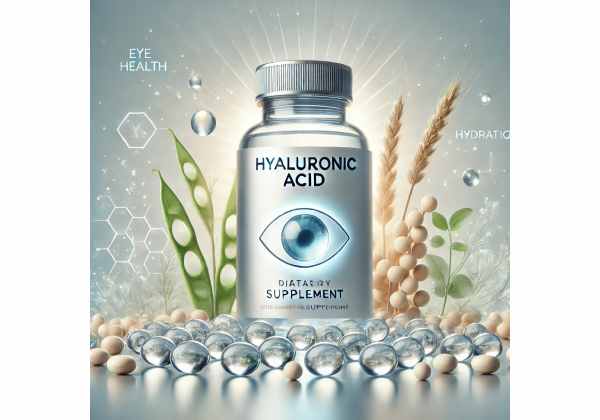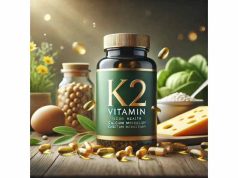
Hyaluronic acid (HA)—a naturally occurring substance abundant in your body’s connective tissues—has garnered increasing attention for its ability to hydrate, lubricate, and support overall tissue health. While many people recognize hyaluronic acid for its skin-plumping or joint-soothing properties, fewer realize it can also play a key role in maintaining clear, comfortable eyesight. From lubricating the ocular surface to reinforcing the vitreous humor inside the eye, hyaluronic acid addresses multiple aspects of vision wellness. In this comprehensive guide, we delve into hyaluronic acid’s mechanisms, its benefits for eye health, and how to integrate it into your daily routine to promote strong, healthy vision.
Table of Contents
- What Exactly Is Hyaluronic Acid?
- Mechanisms: How Hyaluronic Acid Enhances Vision
- Major Gains of Hyaluronic Acid for Eye Wellness
- Best Ways to Utilize Hyaluronic Acid
- Clinical Data and Ongoing Investigations
- Frequently Asked Questions
- References and Sources
What Exactly Is Hyaluronic Acid?
Hyaluronic acid is a glycosaminoglycan—a long chain of sugar molecules—naturally produced in the body. Distinguished by its impressive ability to bind water molecules (up to 1,000 times its own weight), hyaluronic acid serves as a cushioning and hydration component in tissues like the skin, cartilage, and eyes.
Biological Origins
Though popular in the skincare and supplement industries, hyaluronic acid isn’t a foreign additive; it’s an intrinsic part of your physiology:
- Synovial Fluid: Within joints, hyaluronic acid lubricates and absorbs mechanical stress.
- Skin Matrix: HA helps maintain skin elasticity, hydration, and wound healing.
- Vitreous Humor: The clear gel that fills much of your eye’s interior includes hyaluronic acid to sustain shape and optical clarity.
Natural Production and Turnover
Your body constantly synthesizes and degrades hyaluronic acid. Though it’s crucial for healthy tissues, factors like aging, inflammation, UV exposure, and poor diet can diminish your internal HA levels:
- Aging: HA production typically declines with age, possibly affecting joint comfort, skin resilience, and even ocular function.
- Lifestyle Influences: Smoking, stress, and excessive sun exposure may expedite HA breakdown, accelerating dryness or degenerative changes in eyes and skin.
Distinguishing HA from Collagen and Other Components
While collagen provides structural strength, hyaluronic acid contributes lubrication and hydration. They often work together:
- Collagen: Delivers tensile integrity (i.e., shape and firmness).
- Hyaluronic Acid: Maintains moisture equilibrium, essential for flexible, functional tissues.
- Elastin: Helps tissues recoil when stretched.
Recognizing hyaluronic acid’s fundamental role in water retention and lubrication clarifies why it’s increasingly examined for eye-related concerns. A hydrated, elastic ocular environment supports vision by minimizing friction and preserving tissue clarity.
Mechanisms: How Hyaluronic Acid Enhances Vision
The complexities of visual function include corneal clarity, tear film stability, and vitreous humor health. Hyaluronic acid’s capacity for binding moisture and sustaining a lubricious environment suggests multiple pathways through which it can fortify vision.
1. Corneal Hydration and Clarity
The cornea—the transparent, dome-shaped front layer of the eye—relies heavily on balanced hydration for clear vision:
- Surface Lubrication: HA-based eye drops are commonly used to reduce friction between the cornea and eyelids, fighting dryness and irritation.
- Epithelium Support: Hyaluronic acid fosters a favorable environment for corneal epithelial cells, encouraging regeneration if minor abrasions occur.
2. Tear Film Stability
A robust tear film is vital for ocular comfort and clarity, preventing gritty sensations and preserving a smooth refractive surface:
- Water Retention: Hyaluronic acid intensifies tear film thickness and slows evaporation, reducing dryness.
- Reduced Tear Break-Up: By forming a stabilizing layer over the eye, HA helps tears adhere longer, especially in modern lifestyles involving prolonged screen exposure.
3. Maintenance of the Vitreous Body
Behind the lens, the vitreous humor is a gel that occupies most of the eye’s interior volume:
- Structural Role: Hyaluronic acid is a key component in vitreous fluid, preserving transparency and shape.
- Shock Absorption: A well-hydrated vitreous helps dampen sudden impacts, potentially safeguarding the delicate retina.
4. Minimizing Inflammatory Responses
Chronic inflammation in or around the eyes can lead to discomfort, redness, and blurred vision:
- Soothing Irritation: By supporting consistent hydration and a stable tear film, HA indirectly reduces ocular irritation triggers.
- Influencing Wound Healing: In some contexts, hyaluronic acid modulates inflammatory pathways, assisting faster corneal or conjunctival tissue repair.
5. Shielding Against Environmental Stressors
Whether it’s dusty air, allergens, or ultraviolet rays, your eyes face daily environmental assaults:
- Protective Barrier: A hydrated corneal surface is less prone to micro-abrasions or dryness-induced vulnerability to pathogens.
- UV-Related Dryness: Although hyaluronic acid doesn’t block UV radiation, well-lubricated eyes are more resilient against dryness or damage from harsh sunlight.
Major Gains of Hyaluronic Acid for Eye Wellness
Consistent hydration and lubrication are among the most underrated foundations of good vision. From everyday dryness relief to potential roles in preventing more substantial issues, hyaluronic acid’s benefits shine in numerous aspects of ocular health.
1. Relief from Dry Eye Syndrome
Dry eye syndrome arises when tear quantity or quality fails to keep the eyes adequately moistened:
- Combatting Evaporation: Hyaluronic acid has a natural humectant property, locking moisture onto the ocular surface.
- Smoothing Irritation: Enhanced lubrication diminishes redness, itching, or burning sensations that often accompany dryness.
2. Comfort for Contact Lens Wearers
Contact lenses can aggravate dryness by blocking oxygen and wicking tears from the cornea:
- Prolonged Moisture: Eye drops enriched with HA help contact lenses glide more smoothly, mitigating friction.
- Better Lens Tolerance: Many lens-friendly solutions now incorporate hyaluronic acid to extend comfortable wear times and reduce lens-induced dryness.
3. Support After Ocular Surgeries
Procedures like LASIK or cataract surgery can leave the eyes vulnerable to dryness and inflammation:
- Enhanced Post-Surgical Healing: HA’s lubricative effect nurtures delicate tissues, promoting rapid epithelialization.
- Reduced Discomfort: By limiting dryness in the immediate recovery phase, patients experience fewer irritations, leading to a smoother convalescence.
4. Mitigating Eye Strain in Modern Digital Lifestyles
Prolonged screen usage alters blink patterns, causing dryness and discomfort:
- Continuous Tear Film Layer: Hyaluronic acid fosters a more resilient tear layer, important for individuals in screen-intensive jobs.
- Fewer Visual Interruptions: Minimizing dryness episodes helps sustain visual performance, mitigating blurred or double vision that can arise from ocular strain.
5. Overall Optical Clarity
A dehydrated or irritated cornea refracts light inconsistently, undermining sharpness:
- Refined Light Transmission: A moisture-rich corneal surface eliminates micro-distortions, promoting stable clarity.
- Enhanced Comfort Translates to Efficiency: People with well-lubricated eyes generally report less fatigue and more enjoyable day-to-day visual tasks.
6. Indirect Advantages for Retinal and Vitreous Health
Though not a direct cure for deep retinal or macular conditions, a well-hydrated vitreous environment may:
- Maintain Eye Shape: Proper vitreous consistency ensures balanced pressure distributions, indirectly supporting retina attachment.
- Encourage Nutrient Exchange: A stable, hydrated internal environment fosters efficient nutrient and waste transport, crucial for retina longevity.
Best Ways to Utilize Hyaluronic Acid
While the body produces hyaluronic acid naturally, supplementation and topical (including ocular) applications can bolster diminishing levels, especially under conditions like chronic dryness or post-surgery healing. Below are the primary ways to integrate hyaluronic acid into a vision-focused regimen.
1. Eye Drops and Gels
Over-the-counter (OTC) solutions containing hyaluronic acid are popular among individuals seeking quick dryness relief:
- Preservative-Free Formulas: These drops often are well-tolerated for frequent use, crucial for contact lens wearers or sensitive eyes.
- Prolonged Action: Gels (as opposed to watery drops) can remain on the eye surface longer, offering extended moisture.
2. Oral Supplements
Hyaluronic acid capsules or tablets cater to broader joint, skin, and ocular synergy. While the direct impact on eyes may be subtler than topical forms, the systemic approach can be beneficial:
- Multi-Nutrient Complexes: Some supplements merge HA with collagen, vitamins, or minerals to support whole-body and ocular health.
- Absorption Variability: HA’s large molecular structure can pose absorption challenges. Certain formulations are hydrolyzed or use advanced techniques to enhance bioavailability.
3. Topical Applicators for Eyelids or Surrounding Skin
Though not directly inside the eye, certain creams or serums using hyaluronic acid around the eyelids may:
- Improve Periocular Skin Hydration: Maintaining flexible eyelids can influence blinking efficiency, indirectly aiding tear film.
- Prevent Fine Lines: While mostly a cosmetic benefit, well-cared eyelid skin can reduce dryness or irritation triggers.
4. In-Office Medical Procedures
In some ophthalmology or optometry settings, specialized HA-based solutions are used:
- Surgical Lubricants: During cataract or corneal surgeries, a hyaluronic acid solution can protect delicate structures from mechanical stress.
- Advanced Treatments: Emerging techniques explore whether carefully administered HA injections can augment vitreous humor in certain degenerative eye conditions, though these remain experimental.
5. Usage Frequency and Guidelines
Optimal application frequency depends on individual dryness levels and product type:
- Moderate Dryness: 2–3 drops daily in each eye may suffice.
- Severe Dryness or Post-Surgery: More frequent usage, up to once every hour, might be recommended under medical guidance.
- Supplement Doses: Ranging from 50 to 200 mg daily is common, yet best results often emerge over a span of weeks to months.
6. Potential Interactions and Precautions
Overall, hyaluronic acid is well-tolerated. However:
- Allergies: Rare but possible if you have known sensitivities, especially to preservatives in certain eye drop formulas.
- Contamination Risk: Eye drops require meticulous cleanliness to avoid introducing bacteria into the bottle.
- Consultation for Existing Conditions: If you have chronic eye illnesses like advanced glaucoma or severe allergies, a doctor’s input ensures safe usage.
Clinical Data and Ongoing Investigations
Hyaluronic acid’s widespread acceptance in skincare and joint care has paved the way for research into its ocular applications. Although many findings remain preliminary, the collective data endorses a promising role for HA in maintaining eye moisture, surface health, and possibly deeper structural support.
1. Corneal Epithelial Recovery
Multiple small-scale trials highlight the efficacy of HA-based eye drops in hastening the healing of minor corneal abrasions:
- Improved Epithelial Integrity: Subjects saw faster closure of superficial scratches, with significantly less discomfort.
- Reduced Use of Additional Agents: Some studies observed participants needing fewer antibiotic or steroid drops when hyaluronic acid was part of the regimen.
2. Efficacy in Dry Eye Treatments
Randomized controlled trials (RCTs) examining dry eye solutions consistently place hyaluronic acid among the top-tier lubricants:
- Tear Film Stability: Patients using HA-enriched drops demonstrated longer tear break-up times and fewer dryness symptoms.
- Comparison with Standard Options: In many cases, hyaluronic acid performed as well as or better than traditional lubricants without raising safety concerns.
3. Post-Surgical Applications
LASIK, PRK (photorefractive keratectomy), and cataract extraction can leave patients dealing with dryness and mild inflammation:
- HA Versus Saline: Clinical observations show that those receiving HA-based solutions often report quicker comfort restoration and better early visual recovery.
- Potential Anti-Inflammatory Role: While not as potent as steroids, HA’s gentle soothing effect might reduce patients’ reliance on stronger medication.
4. Emerging Research on Vitreous Replacement
The vitreous humor naturally contains hyaluronic acid, prompting interest in whether exogenous HA can address conditions like vitreous detachment or degenerative changes:
- Initial Safety Trials: Trials suggest that carefully formulated HA injections can be introduced into the vitreous cavity, though the technique is complex and not widely mainstream.
- Future Potential: These methods, if refined, could help maintain internal eye pressure and shape in advanced diseases—though more comprehensive data is needed.
5. Oral Intake and Systemic Effects
While topical ocular solutions provide direct corneal contact, interest in oral HA supplementation for eye health is growing:
- General Anti-Inflammatory Support: Some research indicates systemic HA might improve ocular moisture when dryness is part of broader inflammatory issues.
- Time to Benefit: Because oral HA must travel systemically, noticeable improvements may require consistent supplementation over weeks or months.
6. Limitations and Research Gaps
Despite positive directions, gaps remain:
- Long-Term Efficacy: Many studies track short-term endpoints, leaving open questions about multi-year outcomes.
- Optimal Dosage: Variation in product formulas and molecular weights complicates standardization.
- Complexities in Chronic Eye Diseases: The role of HA in advanced macular degeneration or retinal pathologies is not clearly defined yet.
Frequently Asked Questions
Can hyaluronic acid alone fully cure my dry eyes?
Hyaluronic acid is a potent lubricant and can significantly relieve dryness. However, dry eye syndrome often has multiple contributors (e.g., environment, screen time, medical conditions). HA is best seen as part of an integrated approach that might include breaks from screens, hydration, and other medical therapies.
Is there any difference between HA for joints and HA for eyes?
While the core molecule is similar, the formulations can differ. Eye-specific products tend to feature certain viscosities and pH balances, plus sterile conditions suitable for ocular use. HA sold for joint supplements often has different purity criteria or molecular weights.
How quickly might I notice improvements in my vision clarity with HA?
Some people experience immediate relief from dryness upon using HA eye drops. More significant visual clarity or reduced fatigue might emerge over days or weeks of consistent use. Oral supplements generally take longer to exhibit observable results.
Are there any safety concerns with frequent use of HA eye drops?
In general, HA-based drops are well-tolerated, especially if preservative-free. Still, maintaining dropper hygiene is crucial to prevent contamination. If symptoms like redness, pain, or blurred vision worsen, discontinue use and consult an eye care professional.
Will hyaluronic acid help me avoid using glasses or contact lenses?
Hyaluronic acid doesn’t alter refractive errors like nearsightedness or farsightedness. While it supports comfort and hydration—especially for contact lens users—it won’t replace the corrective role of lenses or the benefits of surgical interventions where necessary.
References and Sources
- Aragona, P., & Rolando, M. Ethical and Clinical Impact of Preservatives in Ophthalmic Diseases. Ophthalmic Research, 2017; 57(3): 1–6.
- Elvitigala, S., et al. Hyaluronic Acid: A Multifunctional Ingredient for the Management of Dry Eye. Clinical Ophthalmology, 2020; 14: 4251–4258.
- Pauloin, T., et al. Hyaluronic Acid Eye Drops in the Management of Post-Surgical Ocular Discomfort. Experimental Eye Research, 2017; 165: 188–195.
- De Stefano, V., et al. The Evolving Role of Hyaluronic Acid in Eye Health: A Comprehensive Review. Journal of Ocular Pharmacology and Therapeutics, 2019; 35(6): 339–347.
- Ender, F. K., et al. Efficacy of Hyaluronic Acid-Based Drops vs. Conventional Lubricants: A Meta-Analysis. BMC Ophthalmology, 2021; 21: 385–392.
- Yusufu, M., et al. Oral Hyaluronic Acid Supplementation: Potential Implications for Ocular and Systemic Health. Nutrients, 2018; 10(6): 709–721.
Disclaimer:
This information is offered purely for educational purposes and does not replace professional medical advice. Always consult an optometrist or ophthalmologist for individualized recommendations, especially if you have chronic eye conditions or are on prescription treatments.
If you’ve found these insights on hyaluronic acid and eye care useful, please consider sharing this article on Facebook, X (formerly Twitter), or any other platform you enjoy. Follow us online for more articles and updates on supporting sharp vision and overall wellbeing!










